Bronchovesicular sounds - Study guides, Class notes & Summaries
Looking for the best study guides, study notes and summaries about Bronchovesicular sounds? On this page you'll find 1061 study documents about Bronchovesicular sounds.
Page 3 out of 1.061 results
Sort by
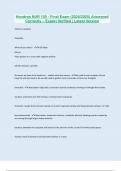
-
Hondros NUR 155 - Final Exam (2024/2025) Answered Correctly – Expert Verified | Latest Version
- Exam (elaborations) • 9 pages • 2024
- Available in package deal
-
- $8.49
- + learn more
Airborne Isolation Examples What do you wear? - N-95 Mask Gloves Place patient in a room with negative airflow EX) TB, measles, varicella As nurses we have to be explorers... explain what this means - We need to ask ourselves, Do we have the info we need or do we still need to gather some more data to form our thoughts bronchial - description: high pitch, loud harsh sounds created by moving air through the trachea location: anteriorly over the trachea, not heard over lung tissue charac...
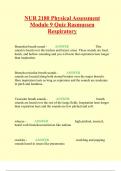
-
NUR 2180 Physical Assessment Module 9 Quiz Rasmussen Respiratory
- Exam (elaborations) • 6 pages • 2024
-
- $7.99
- + learn more
NUR 2180 Physical Assessment Module 9 Quiz Rasmussen Respiratory Bronchial breath sound - ANSWER This sound is heard over the trachea and larynx areas. These sounds are loud, harsh, and hollow sounding and you will note that expiration lasts longer than inspiration. Bronchovesicular breath sounds - ANSWER sounds are located along both sternal borders over the major bronchi. Here inspiration lasts as lon...
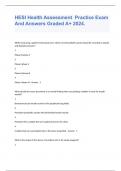
-
HESI Health Assessment Practice Exam And Answers Graded A+ 2024.
- Exam (elaborations) • 98 pages • 2024
-
Available in package deal
-
- $8.29
- + learn more
While measuring a patient's blood pressure, which set of Korotkoff sounds should be recorded as systolic and diastolic pressure? 1 Phase III/phase V 2 Phase I/phase V 3 Phase II/phase III 4 Phase I/phase IV - Answer 2 What should the nurse document as a normal finding when auscultating a toddler's chest for breath sounds? 1 Bronchovesicular breath sounds in the peripheral lung fields 2 Persistent peristaltic sounds with diminished breath sounds 3 Persistent fine crackles tha...

-
Final PN111 Herzing University Latest Update Graded A+
- Exam (elaborations) • 14 pages • 2024
-
- $9.99
- + learn more
Final PN111 Herzing University Latest Update Graded A+ Eupnea means: normal breathing Tachypnea rapid breathing bradypnea slow breathing orthopnea difficulty breathing when lying down Dyspnea difficulty breathing apnea absence of breathing What tells you a patient is having difficulty breathing? Using accessory muscles, nasal flaring, cyanosis, tripod position Barrell Chest 1:1, related to lung overinflated and increase in A/P diameter Normal is 1:2 Angle of Louis...

-
Shadow Health Respiratory Concept Lab: (NURS612) Advanced Health Assessment | Graded.
- Exam (elaborations) • 5 pages • 2024
- Available in package deal
-
- $11.49
- + learn more
Shadow Health Respiratory Concept Lab: (NURS612) Advanced Health Assessment | Graded. What happens during auscultation? {{Ans- Healthcare professional listen to the heart sounds through a stethoscope What are bronchial sounds and how are these sounds detected? {{Ans- Harsh, high-pitched, & loud sound that can be heard above the manubrium (over the trachea). What are bronchovesicular sounds and how are these sounds detected? {{Ans- Medium in loudness & pitch sounds that can be heard over th...
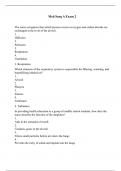
-
Med Surg A Exam 2
- Exam (elaborations) • 72 pages • 2024
-
- $13.00
- + learn more
The nurse recognizes that which process occurs as oxygen and carbon dioxide are exchanged at the level of the alveoli. 1. Diffusion 2. Perfusion 3. Respiration 4. Ventilation 3. Respiration Which structure of the respiratory system is responsible for filtering, warming, and humidifying inhaled air? 1. Alveoli 2. Pharynx 3. Sinuses 4. Turbinates 4. Turbinates In providing health education to a group of middle school students, how does the nurse describe the function of the ...
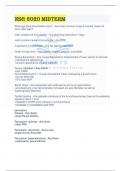
-
NSG 6020 MIDTERM |COMPREHENSIVE QUESTIONS AND ANSWERS 100% Accuracy |LATEST UPDATE 2024 |What age does bronchiolitis occur?
- Exam (elaborations) • 7 pages • 2024
-
- $9.49
- + learn more
What age does bronchiolitis occur?main symptom of bronchiolitismost common cause of bronchiolitisTreatment for bronchiolitisOrder of lung examPectus ExcavatumPectus carinatumBarrel ChestBarrel ChestTactile fremituspercussion: flatnessPercussion- dullnessPercussion: resonancePercussion: hyperresonance Percussion: tympany Auscultation: vesicular Auscultation: bronchial Auscultation: bronchovesicular Auscultation: tracheal Rhonchi Wheezesstridor loud, rough, continuous, high-pitched sound that is...
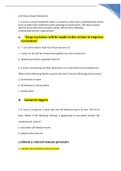
-
West Coast University MED SURG 3 480 ATI FINAL EXAM VERSION B QUESTIONS AND 100% CORRECT ANSWERS
- Exam (elaborations) • 32 pages • 2023
-
- $18.19
- 2x sold
- + learn more
ATI FINAL EXAM VERSION B 1. A nurse in a burn treatment center is caring for a client who is admitted with severe burns to both lower extremities and is pending an escharotomy. The client’s spouse asks the nurse what the procedure entails. Which of the following nursing statements is appropriate? a. “large incisions will be made in the eschar to improve circulation” b. “ I can call the doctor back here if you want me to” c. “a piece of skin will be removed and grafted ov...
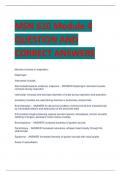
-
MSN 610 Module 4 QUESTION AND CORRECT ANSWERS
- Exam (elaborations) • 17 pages • 2024
- Available in package deal
-
- $13.49
- + learn more
MSN 610 Module 4 QUESTION AND CORRECT ANSWERS Muscles involved in respiration: Diaphragm Intercostal muscles Sternocleidomastoid, scalenus, trapezius - ANSWER Diaphragm: dominant muscle, contracts during inspiration intercostal: increase and decrease diameter of chest during inspiration and expiration accessory muscles are used during exercise or pulmonary compromise Bronchiectasis - ANSWER An abnormal condition of the bronchial tree characterized by irreversible dilation and dest...
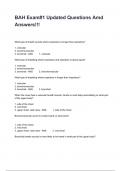
-
BAH Exam#1 Updated Questions Amd Answers!!!
- Exam (elaborations) • 15 pages • 2024
-
Available in package deal
-
- $9.39
- + learn more
What type of breath sounds where inspiratory is longer than expiratory? 1. vesicular 2. bronchovesicular 3. bronchial - ANS 1. vesicular What type of breathing where inspiratory and expiratory is about equal? 1. vesicular 2. bronchovesicular 3. bronchial - ANS 2. bronchovesicular What type of breathing where expiratory is longer than inspiratory? 1. vesicular 2. bronchovesicular 3. bronchial - ANS 3. bronchial When the nurse hear a vesicular bre...

Did you know that on average a seller on Stuvia earns $82 per month selling study resources? Hmm, hint, hint. Discover all about earning on Stuvia


